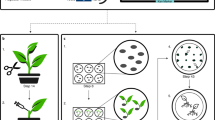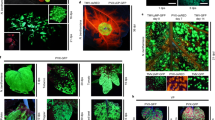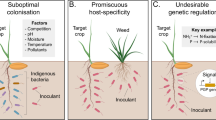Abstract
Little is known about the consequences of releasing genetically engineered plants (GEP) into the environment. Using opine-producing GEP, we show that transgenic plants alter their biological environment, more precisely the root-associated bacterial populations. The alterations were both transgene-specific and target population-specific. Therefore, assessment studies on the introduction of a given transgene into a GEP will be valid on the given transgene. Evidence of any transgene-associated biological effect will depend on the determination of the pertinent target populations, the identification of which is a key step of such studies.
This is a preview of subscription content, access via your institution
Access options
Subscribe to this journal
Receive 12 print issues and online access
$209.00 per year
only $17.42 per issue
Buy this article
- Purchase on Springer Link
- Instant access to full article PDF
Prices may be subject to local taxes which are calculated during checkout
Similar content being viewed by others
References
Potrykus, I. 1991. Gene transfer to plants: assessment of published aproaches and results. Ann. Rev. Plant Physiol. Plant Mol. Blol. 42: 205–225.
Kung, S.-D. and Wu, R. 1993. (eds). Transgenic plants, vol. 2. Academic Press, San Diego, CA.
Dessaux, Y., Petit, A., and Tempé, J. 1992. Opines in Agrobacterium biology, pp. 109–136 in Molecular signals in plant-microbe communications. Verma, D.P.S. (ed). CRC Press, Boca Raton, FL.
Zambryski, P.C. 1992. Chronicles from the Agrobacterium-plant cell DNA transfer story. Ann. Rev. Plant Physiol. Plant Mol. Biol. 43: 465–490.
Gaudin, V., Vrain, T., and Jouanin, L. 1994. Bacterial genes, modifying hormonal balances in plants. Plant Physiol. Biochem. 32: 11–29.
Tremblay, G., Gagliardo, R., Chilton, W.S., and Dion, P. 1987. Diversity among opine-utilizing bacteria: identification of coryneform isolates. Appl. Environ. Microbiol. 53: 1519–1524.
Nautiyal, C.S. and Dion, P. 1990. Characterization of the opine-utilizing microflora associated with samples of soil and plants. Appl. Environ. Microbiol. 56: 2576–2579.
O'Connell, K.P., Goodman, R.M., and Handelsman, J. 1996. Engineering the rhizosphere: expressing a bias. Trends Biotechnol. 14: 83–88.
Dessaux, Y., Tempé, J., and Farrand, S.K. 1987. Genetic analysis of mannitylopine catabolism in octopine-type strain 15955. Mol. Gen. Genet. 208: 301–308.
Guyon, P., Petit, A., Tempé, J., and Dessaux, Y. 1993. Transformed plants producing opines specifically promote growth of opine-degrading Agrobacteria. Molec. Plant-Microbe Interactions 6: 92–98.
Wilson, M., Savka, M.A., Farrand, S.K., and Lindow, S.E. 1995. Altered epiphytic colonization of mannityl opine-producing transgenic tobacco plants by a mannityl opine-catabolizing strain of Pseudomonas syringae. Appl. Environ. Microbiol. 61: 2151–2158.
Savka, M.A. and Farrand, S.K. . Modification of rhizobacterial populations by engineering bacterial utilization of a novel plant-produced resource. Nature Biotechnology. 15: 363–368.
Petit, A., Stougaard, J., Kühle, A., Marcker, K.A., and Tempé, J. 1987. Transformation and regeneration of the legume species Lotus corniculatus: a system for molecular studies of symbiotic nitrogen fixation. Mol. Gen. Genet. 207: 245–250.
Cardarelli, M., et al. 1987. Agrobacterium rhizogenes T-DNA genes capable of inducing hairy root phenotype. Mol. Gen. Genet. 209: 475–480.
Spena, A., Schmülling, T., Koncz, C., and Schell, J. 1987. Independent and synergistic activity of rolA, B and C loci in stimulating adnormal growth in plants. EMBO J. 6: 3891–3899.
Tate, M.E. et al. 1982. Agropine: a revised structure. Carbohydrate Res. 104: 105–120.
Savka, M.A. and Farrand, S.K. 1992. Mannityl opine accumulation and exudation by transgenic tobacco. Plant Physiol. 98: 784–789.
Savka, M.A. et al. 1996. Translocation and exudation of tumor metabolites in crown galled plants. Molec Plant Microbe Interactions 9: 310–313.
Dommergue, Y.R. and Mangenot, F. 1970. (eds). Ecologie Microbienne du Sol. Masson, Paris.
Wilson, M. and Lindow, S.E. 1994. Coexistence among epiphytic bacterial populations mediated through nutritional resource partitioning. Appl. Environ. Microbiol. 60: 4468–4477.
Curl, E.A. and Truelove, B. (eds). 1986. The rhizosphere. Springer-Verlag, Berlin.
Oger, P. 1995. Etudes sur la possibilité de favoriser spécifiquement la croissance de bactéries de la rhizosphère—Le cas des plantes transgéniques productrices d'opines. Thèse de I'Université de Paris-sud, Orsay.
Colbert, S.F. et al. 1993. Use of an exotic carbon source to selectively increase metabolic activity and growth of Pseudomonas putida in soil. Appl. Environ. Microbiol. 59: 2056–2063.
Colbert, S.F., Schroth, M.N., Weinhold, A.R., and Hendson, M. 1993. Enhancement of population densities of Pseudomonas putida PpG7 in agricultural ecosystems by selective feeding with the carbon source salycilate. Appl. Environ. Microbiol. 59: 2064–2070.
Brevet, J., Borowski, D. and Tempé, J. 1988. Identification of the region encoding opine synthesis and of a region involved in hairy root induction on the T-DNA of a cucumber-type Ri plasmid. Molec. Plant-Microbe Interactions 1: 75–79.
White, F.F. and Nester, E.W. 1980. Hairy root: plasmid encodes virulence traits in A. rhizogenes. J. Bacteriol. 141: 1134–1141.
Brevet, J. and Tempé, J. 1988. Homology mapping of T-DNA regions on three Agrobacterium rhizogenes Ri plasmids by electron microscope heteroduplex studies. Plasmid 19: 75–83.
Morel, G. and Wetmore, R.H. 1951. Fern callus culture. Am. J. Bot. 38: 141–143.
Hiltner, L. 1904. Über neuere Erfahrungen und Probleme auf dem Gebeit der Bodenbakteriologie und unter besonderer Berücksichtigung des Gründüngung und Brachte. Abs. Dtsch. Landwirt Ges. 98: 59–78.
Vaudequin-Dransart, V. et al. 1995. Novel Ti plasmids in Agrobacterium tumefaciens strains isolated from fig tree and chrysanthemum tumors and their opine-like molecules. Mol. Plant-Microbe Interactions 8: 311–321.
Glickmann, E. and Dessaux, Y. 1995. A critical examination of the specificity of the Salkowski reagent for indolic compounds produced by phytophatogenic bacteria. Appl. Environ. Microbiol. 61: 793–796.
Petit, A. and Tempé, J. 1978. Isolation of Agrobacterium regulatory mutants. Mol. Gen. Gent. 167: 147–155.
Author information
Authors and Affiliations
Rights and permissions
About this article
Cite this article
Oger, P., Petit, A. & Dessaux, Y. Genetically engineered plants producing opines alter their biological environment. Nat Biotechnol 15, 369–372 (1997). https://doi.org/10.1038/nbt0497-369
Received:
Accepted:
Issue Date:
DOI: https://doi.org/10.1038/nbt0497-369
This article is cited by
-
Engineering rhizobacteria for sustainable agriculture
The ISME Journal (2021)
-
Nitrogen fixation in maize: breeding opportunities
Theoretical and Applied Genetics (2021)
-
Effect of transgenic cotton continuous cropping on soil bacterial community
Annals of Microbiology (2020)
-
Control of nitrogen fixation in bacteria that associate with cereals
Nature Microbiology (2019)
-
Engineering transkingdom signalling in plants to control gene expression in rhizosphere bacteria
Nature Communications (2019)



